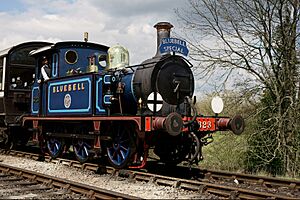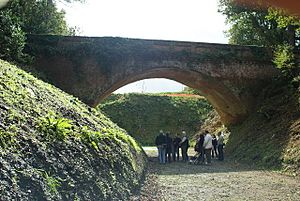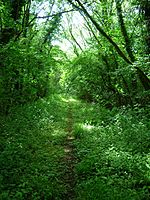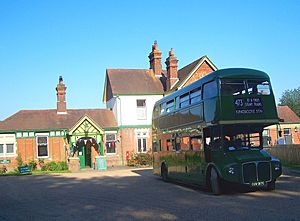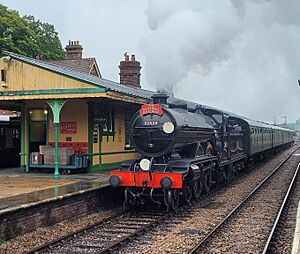Bluebell Railway facts for kids
Quick facts for kids Bluebell Railway |
|
|---|---|
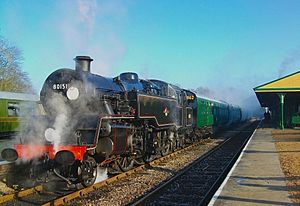
British Railways Standard Class 4 No. 80151 and its train are seen at Horsted Keynes
|
|
| Terminus | East Grinstead |
| Commercial operations | |
| Built by | London, Brighton and South Coast Railway |
| Original gauge | 4 ft 8 1⁄2 in (1,435 mm) standard gauge |
| Preserved operations | |
| Operated by | Bluebell Railway Preservation Society |
| Stations | 4 |
| Length | 11 mi (17.7 km) |
| Preserved gauge | 4 ft 8 1⁄2 in (1,435 mm) standard gauge |
| Commercial history | |
| Opened | 1 August 1882 |
| Closed | 17 March 1958 |
| Preservation history | |
| 1960 | Re-opens to the public between Sheffield Park and Bluebell Halt |
| 1962 | Extension opens from Bluebell Halt to Horsted Keynes |
| 1994 | Extension to Kingscote re-opened |
| 2013 | Extension to East Grinstead re-opened |
| Headquarters | Sheffield Park station |
The Bluebell Railway is a special 11-mile (17.7 km) long heritage railway in West Sussex, England. It's run by the Bluebell Railway Preservation Society. This railway uses old-fashioned steam trains. They travel between Sheffield Park and East Grinstead. Along the way, they stop at Horsted Keynes and Kingscote.
This railway was the first in the world to save and run a standard gauge steam passenger service for the public. The society started its first train rides on August 7, 1960. This was less than three years after the original line closed.
On March 23, 2013, the Bluebell Railway began running trains all the way to its new station at East Grinstead. At East Grinstead, the Bluebell Railway connects to the national train network. This was the first time in 50 years the Bluebell Railway had a connection to the main lines.
Today, many dedicated volunteers help manage and run the railway. The Bluebell Railway saved many steam locomotives even before steam trains stopped running on main British lines in 1968. Now, it has over 30 steam locomotives. This is the second-largest collection in the UK. The railway also has almost 150 old carriages and wagons. Most of these were built before 1939.
Contents
The Bluebell Railway's Story
| Lewes and East Grinstead Railway Act 1877 | |
|---|---|
| Act of Parliament | |

|
|
| Long title | An Act for incorporating the Lewes and East Grinstead Railway Company; and for other purposes. |
| Citation | 40 & 41 Vict. c. ccxviii |
| Dates | |
| Royal assent | 10 August 1877 |
| Text of statute as originally enacted | |
In 1877, a special law was passed. It allowed the Lewes and East Grinstead Railway (L&EGR) to be built. Rich local landowners, like the Earl of Sheffield, helped fund the line. A year later, another law let the London, Brighton and South Coast Railway Company (LB&SCR) take over the line.
The branch line had six stations. Only Barcombe was close to a village. Other stations were built near the homes of the people who supported the railway. For example, Sheffield Park station was for the Earl of Sheffield. The other stations were at Kingscote, West Hoathly, and Horsted Keynes.
The laws from 1877 and 1878 said that four passenger trains had to run each way daily. They also had to connect to London at East Grinstead. This rule meant the railway had to keep running trains.
The line was built to hold two tracks. However, only the section between East Grinstead and Horsted Keynes had two tracks. South of Horsted Keynes, it was a single track with places for trains to pass. The railway opened in 1882.
Trains carried local goods like milk, farm products, and coal. They also moved timber for a sawmill. Sheffield Park station only got a lot of passengers when Lord Sheffield invited the Australian cricket team to play a match.
A Sad Accident in 1943
On July 31, 1943, a sad accident happened. A newly married couple, Ronald Knapp and Winifred Standing, were near the railway tracks. It was a dark and rainy night. A train was traveling from Lewes to East Grinstead.
When the train reached Horsted Keynes, a guard found a blood-covered raincoat. Another coat was found near two bodies on the tracks. An investigation found that the couple had been walking with their backs to the train. The weather was very bad, so they likely did not hear the train coming. The coroner said the couple were on the tracks without permission. No railway worker was blamed. The couple was buried together at St Giles' Church, Horsted Keynes.
The Line Closes Down
In 1954, British Railways suggested closing the line. Local people fought against this idea. The line was supposed to close in June 1955, but a rail strike delayed it. It finally closed on May 29, 1956.
A big argument then started between British Railways and the people who used the Bluebell Line. It lasted for three years. A local resident, Margery Bessemer, found the old laws from 1877 and 1878. These laws said British Railways had to keep running trains.
So, on August 7, 1956, British Railways reopened the line. Trains stopped at the stations mentioned in the old laws. British Railways tried to change the law in 1957. They eventually succeeded, and the line finally closed on March 17, 1958.
Saving the Railway
On March 15, 1959, a group of people met in Ardingly. They formed the Lewes & East Grinstead Railway Preservation Society. Bernard Holden, who later became the society's president, was part of this group. They raised £940 to start the society. At the meeting, they voted to change the name to the Bluebell Railway Preservation Society.
At first, the society wanted to reopen the whole line. They hoped to run a regular train service. But these plans didn't work out. The society couldn't buy the whole line, and most local people weren't interested. So, the committee decided to run a shorter section as a tourist attraction. They would use old trains and have volunteers run everything.
From Sheffield Park to Horsted Keynes
British Rail still had an electric line from Horsted Keynes to Ardingly. So, the society rented a section of track just south of this. In 1960, the first part of the preserved line opened. It ran from Sheffield Park to Bluebell Halt. This halt was about 100 yards (91 m) south of Horsted Keynes.
In 1962, the society extended its services to Horsted Keynes. A new stop called Holywell (Waterworks) also opened that year. However, it closed the next year. In 1963, British Rail stopped passenger services north of Horsted Keynes. This cut off the Bluebell Line from the main British Rail system.
From Horsted Keynes to Kingscote
In 1974, the society bought the land where West Hoathly station used to be. This was the first step towards extending the line north. Then, in 1985, they bought the land for Kingscote station.
These efforts led to a public meeting. In 1985, the government gave permission to extend the line to East Grinstead. The Bluebell Railway Preservation Society finished the extension from Horsted Keynes to Kingscote in April 1994. They relaid tracks through Sharpthorne Tunnel. This tunnel is 731 yards or 668 metres long. It is the longest tunnel on a UK heritage railway.
At the north end of Sharpthorne Tunnel, the line passes the old West Hoathly station site. The station was taken down in 1967. But you can still see parts of the platforms.
In 2010, the Bluebell Railway celebrated 50 years of running trains. They held a big event with all their available engines. Some of the society's first members came to mark the arrival of a special train.
From Kingscote to East Grinstead
From the very beginning, the society wanted to reach East Grinstead. This would connect the line to the national network. British Rail gave Imberhorne Viaduct to the railway in 1992. But the society only bought the last parts of the track bed to East Grinstead in 2003. This allowed construction work to begin that year.
A big challenge was an old landfill site. It was in a 30-foot-deep (9.1 m) cutting south of Imberhorne Viaduct. The local council had filled it with household waste in the 1960s and 1970s. Tests showed that the 96,000 cubic metres (3,400,000 cu ft) of waste was not harmful.
The soil covering the landfill was moved south by train. It was used to fill in an old viaduct site. In January 2008, work began to clear plants from the landfill section. On November 25, 2008, BBC newsreader Nicholas Owen helped start the removal of the waste.
At first, rubbish was taken away by lorries. But this was very expensive. So, in 2009, they tried removing the waste by train. This was cheaper, but still costly. A new tax on landfill waste was coming in April 2012. This would make removal much more expensive. The society started an appeal to raise money. They wanted to remove all the waste by March 2012. Thanks to donations, they met their goal. The rubbish was removed by train just in time.
In late 2008, work started at East Grinstead to build the new station. It was about 100 yards (91 m) south of the national rail station. In 2010, Dame Vera Lynn helped launch an appeal to raise £3.8 million. Most of this money was for reconnecting the line to East Grinstead.
On March 7, 2013, the very last section of track was joined. A long-time volunteer, Barbara Watkins, tightened the final bolts. The extension to East Grinstead officially opened on Saturday, March 23, 2013. A two-week opening festival celebrated this big achievement.
West: Horsted Keynes to Ardingly
This line was originally built with two tracks. It was electrified in the 1930s. In its final years, it ran as a single track. The second track was used to store carriages.
After the line closed in 1963, a local person bought the land. In the 1990s, the society bought the abandoned track bed between Horsted Keynes and Ardingly. This included the land up to the Hanson Aggregates depot.
The society hopes to connect this line to Network Rail again. This would allow access to the main London to Brighton line. There are ideas to restore the line with electric power. This would let the society use its electric trains.
The 218-yard (199 m) Lywood Tunnel is still in good shape. But two big jobs are needed to reopen the line. A short bridge needs replacing. Also, the 117-yard (107 m) Sheriff Mill Viaduct was taken down in 1969. It needs to be rebuilt. The clay from the Imberhorne cutting was placed near the old viaduct site. This will help when building a new bridge. In 2013, a bridge from another old railway was given to the Bluebell Railway. It will be used for the new Sheriff Mill Viaduct.
South: Sheffield Park to Lewes
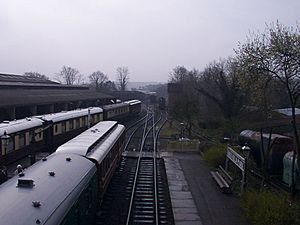
In the past, Lewes station was a busy hub. Many lines met there, connecting to the coast and London. Today, Lewes still has several train lines.
The Bluebell Line was once the fastest way from Lewes to London. It ran south from Sheffield Park to Culver Junction. There were stations at Newick and Chailey and Barcombe. At Culver Junction, it joined another line to reach Lewes. The section from East Grinstead to Culver Junction closed in 1958. The Lewes to Uckfield line closed in 1969.
Some Bluebell supporters want to rebuild the line south to Lewes. However, this would be very difficult. Many large obstacles are in the way. For example, a main road (the A275 road) has been widened and moved. There are also old landfill sites that need to be dug up. A large housing estate has been built on the old Newick and Chailey station site.
The part of the line that is still undeveloped is now a path for walking and horse riding.
Stations Along the Line
The stations on the Bluebell Railway have been restored. Each one looks like it did during a different time in the railway's history:
- Sheffield Park looks like a Victorian station. This is how it would have appeared before 1922.
- Horsted Keynes looks like a Southern Railway station from 1923 to 1947.
- Kingscote looks like a British Railways station from the 1950s.
- East Grinstead combines the look of British Railways from the 1950s and 1960s.
Current Heritage Stations
- East Grinstead to Sheffield Park
- East Grinstead
- Kingscote
- West Hoathly (closed)
- Horsted Keynes
- Bluebell Halt (closed)
- Holywell (Waterworks) (closed)
- Freshfield Halt (closed)
- Ketches Halt (closed)
- Sheffield Park
- Horsted Keynes to Ardingly (planned)
- Horsted Keynes
- Ardingly (planned)
Original Stations
- Lewes to East Grinstead (Low Level)
- East Grinstead
- Kingscote
- West Hoathly
- Horsted Keynes
- Sheffield Park
- Newick and Chailey
- Barcombe
- Lewes
Amazing Rolling Stock
The Bluebell Railway saved many steam locomotives. They did this before steam trains stopped running on main British lines in 1968. Today, the railway has over 30 steam locomotives. This is the largest collection in the UK after the National Railway Museum. The society also has almost 150 carriages and wagons. Most of these were built before World War II.
In October 2000, the Bluebell Railway announced a big project. They planned to build a copy of an old steam engine called SR/BR period LB&SCR H2 class Atlantic Beachy Head. Many old parts were gathered for this project. This included a boiler from another old engine. The boiler was tested around August 2018. The new locomotive was finished and joined to its tender on March 5, 2024. It began running services on August 18, 2024.
In April 2008, the Heritage Lottery Fund gave the railway £2.8 million. This money helped build new shelters for up to 17 carriages at Sheffield Park. The funds also helped create a museum and learning area. New facilities for train crews were built. A system to collect rainwater from the roof was also installed. This water is cleaned and used to fill the steam engines' boilers. The money also helped restore the railway's historic station buildings.
Railway Friends
The Bluebell Railway has a special friendship with another heritage railway. It is twinned with the Museumstoomtram Hoorn – Medemblik. This railway connects Hoorn and Medemblik in the Netherlands.


